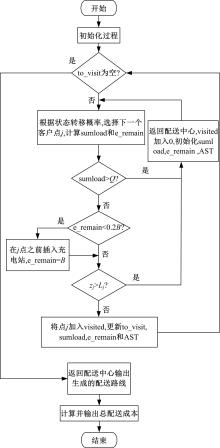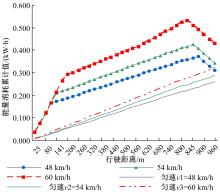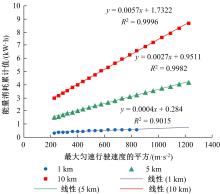Journal of Jilin University(Engineering and Technology Edition) ›› 2023, Vol. 53 ›› Issue (4): 1047-1059.doi: 10.13229/j.cnki.jdxbgxb.20210822
Electric delivery vehicle routing problem with flexible time window integrated with energy consumption estimation
Bao-feng SUN( ),Jiao-jiao LIU,Tian-zi YAO,Xin-xin REN
),Jiao-jiao LIU,Tian-zi YAO,Xin-xin REN
- College of Transportation,Jilin University,Changchun 130022,China
CLC Number:
- N945.15
| 1 | 新能源汽车舆情中心. 2017年电动物流车产销或现“井喷” [EB/OL]. [2021-01-23]. . |
| 2 | 李明. 从政策法规层面浅析纯电动物流车发展趋势[J]. 科技资讯, 2018, 16(8): 92-93. |
| Li Ming. Analyze the development trend of pure electric logistics vehicle from the level of policies and regulations[J]. Science & Technology Information, 2018, 16(8): 92-93. | |
| 3 | 中共中央国务院. 交通强国建设纲要[EB/OL]. [2021-01-16].交通强国建设纲要. |
| 4 | Demir E, Bektaş T, Laporte G. A review of recent research on green road freight transportation[J]. European Journal of Operational Research, 2014, 237(3): 775-793. |
| 5 | Schneider M, Stenger A, Goeke D. The electric vehicle routing problem with time windows and recharging stations[J]. Transport Science, 2014, 48(4): 500-520. |
| 6 | Schiffer M, Schneider M, Laporte G. Designing sustainable mid-haul logistics networks with intra-route multi-resource facilities[J]. European Journal of Operational Research, 2018, 265(2): 517-532. |
| 7 | Macrina G, Pugliese L D P, Guerriero F, et al. The green mixed fleet vehicle routing problem with partial battery recharging and time windows[J]. Computers & Operations Research, 2019, 101: 183-199. |
| 8 | Bektas T, Laporte G. The pollution-routing problem[J]. Transportation Research Part B: Methodological, 2011, 45(8): 1232-1250. |
| 9 | Goeke D, Schneider M. Routing a mixed fleet of electric and conventional vehicles[J]. European Journal of Operational Research, 2015, 245(1): 81-99. |
| 10 | Turkensteen M. The accuracy of carbon emission and fuel consumption computations in green vehicle routing[J]. European Journal of Operational Research, 2017, 262(2): 647-659. |
| 11 | Bassoa R, Kulcsárb B, Egardtb B, et al. Energy consumption estimation integrated into the electric vehicle routing problem[J]. Transportation Research Part D: Transport and Environment, 2019, 69(4): 141-167. |
| 12 | 王琪瑛, 李英, 李惠. 带软时间窗的电动车换电站选址路径问题研究[J]. 工业工程与管理, 2019, 24(3): 99-106. |
| Wang Qi-ying, Li Ying, Li Hui. Battery swap location-routing problem of electric vehicles with soft time windows[J]. Industrial Engineering and Management, 2019, 24(3): 99-106. | |
| 13 | Hiermann G, Puchinger J, Ropke S, et al. The electric fleet size and mix vehicle routing problem with time windows and recharging stations[J]. European Journal of Operational Research, 2016, 252(3): 995-1018. |
| 14 | Taş D, Jabali O, Woensel T V. A vehicle routing problem with flexible time windows[J]. Computers & Operation Research, 2014, 52(A): 39-54. |
| 15 | Zhang H Z, Zhang Q W, Ma L, et al. A hybrid ant colony optimization algorithm for a multi-objective vehicle routing problem with flexible time windows[J]. Information Sciences, 2019, 490: 166-190. |
| 16 | 葛斌. 求解车辆路径问题的蚁群优化算法研究及应用[D]. 合肥: 合肥工业大学计算机与信息学院,2016. |
| Ge Bin. Research and application of ant colony optimization algorithm in solving the vehicle routing problem[D]. Hefei: School of Computer Science and Information Engineering, Hefei University of Technology, 2016. | |
| 17 | 陈宝文. 蚁群优化算法在车辆路径问题中的应用研究[D]. 哈尔滨: 哈尔滨工业大学航天学院, 2009. |
| Chen Bao-wen. Application of ant colony optimization in vehicle routing problems[D]. Harbin: School of Astronautics, Harbin Institute of Technology, 2009. | |
| 18 | 刘云忠, 宣慧玉. 蚂蚁算法在带时间窗车辆路径问题中的应用研究[C]∥中国运筹学会第七届学术交流会, 北京,中国,2004: 8-15. |
| Liu Yun-zhong, Xuan Hui-yu. Application research of the ant algorithm to vehicle routing problem with time windows[C]∥The 7th Conference of Operations Research Society of China, Beijing,China, 2004: 8-15. | |
| 19 | 王永聪. 基于纯电动汽车的城市配送车辆路径问题研究[D]. 北京: 北京交通大学交通运输学院, 2016. |
| Wang Yong-cong. Research on vehicle routing problem of city distribution based on pure electric vehicle[D]. Beijing: School of Traffic and Transportation, Beijing Jiaotong University, 2016. | |
| 20 | 宋稚雅. 基于纯电动物流车的城市配送车辆路径问题研究[D]. 北京: 北京交通大学经济与管理学院, 2019. |
| Song Zhi-ya. Study on urban distribution vehicle routing problem based on pure electric logistics vehicle[D]. Beijing: School of Economics and Management, Beijing Jiaotong University, 2019. |
| [1] | Ying HU,Chun-fu SHAO,Shu-ling WANG,Xi JIANG,Hai-rui SUN. Identification of road riding quality based on shared bike trajectory data [J]. Journal of Jilin University(Engineering and Technology Edition), 2023, 53(4): 1040-1046. |
| [2] | Zhan-zhong WANG,Ting JIANG,Jing-hai ZHANG. Evaluation of road transportation efficiency based on fuzzy double frontiers network model [J]. Journal of Jilin University(Engineering and Technology Edition), 2023, 53(2): 385-395. |
| [3] | Bao-feng SUN,Tian-zi YAO,Yu-qi CHEN. Electric delivery vehicle routing problem optimization model with time⁃varying traffic congestion [J]. Journal of Jilin University(Engineering and Technology Edition), 2023, 53(2): 468-479. |
| [4] | Yun-juan YAN,Wei-xiong ZHA,Jun-gang SHI,Jian LI. Mixed network equilibrium model with stochastic charging demand [J]. Journal of Jilin University(Engineering and Technology Edition), 2022, 52(1): 136-143. |
| [5] | Zuo-an HU,Yi-ming XIA,Jia CAI,Feng XUE. Optimization of urban rail transit operation adjustment based on multiple strategies under delay [J]. Journal of Jilin University(Engineering and Technology Edition), 2021, 51(5): 1664-1672. |
| [6] | Hao LI,Hao CHEN. Mixed traffic network equilibrium with battery electric vehicles considering charging queuing time [J]. Journal of Jilin University(Engineering and Technology Edition), 2021, 51(5): 1684-1691. |
| [7] | Cai-hua ZHU,Xiao-li SUN,Yan LI. Forecast of urban public bicycle traffic demand by station classification [J]. Journal of Jilin University(Engineering and Technology Edition), 2021, 51(2): 531-540. |
| [8] | Qing-yu LUO,Wan-li TIAN,Hong-fei JIA. Location and capacity model of electric vehicle charging station considering commuting demand [J]. Journal of Jilin University(Engineering and Technology Edition), 2019, 49(5): 1471-1477. |
| [9] | CAO Qian, LI Jun, LIU Yu, QU Da-wei. Construction of driving cycle based on Markov chain for passenger car in Changchun City [J]. Journal of Jilin University(Engineering and Technology Edition), 2018, 48(5): 1366-1373. |
| [10] | SUN Bao-feng, GAO Kun, SHEN Xiu-xiu, LIANG Ting. Location model of gas station for network expansion based on capacity balance and variable coverage radius [J]. 吉林大学学报(工学版), 2018, 48(3): 704-711. |
| [11] | SHAO Sai, BI Jun, GUAN Wei. Electric vehicle routing problem with charging and dynamic customer demands [J]. 吉林大学学报(工学版), 2017, 47(6): 1688-1695. |
| [12] | XU Liang,CHENG Guo-zhu. Setting minimum vehicle speed limit on freeway based on speed scattering and economic speed [J]. 吉林大学学报(工学版), 2010, 40(03): 661-0665. |
| [13] | Lu Ying-rong,Yang Yin-sheng,Lv Feng . Optimal vehicle routing problem based on fuzzy clustering analysis [J]. 吉林大学学报(工学版), 2006, 36(增刊2): 147-151. |
|
||





